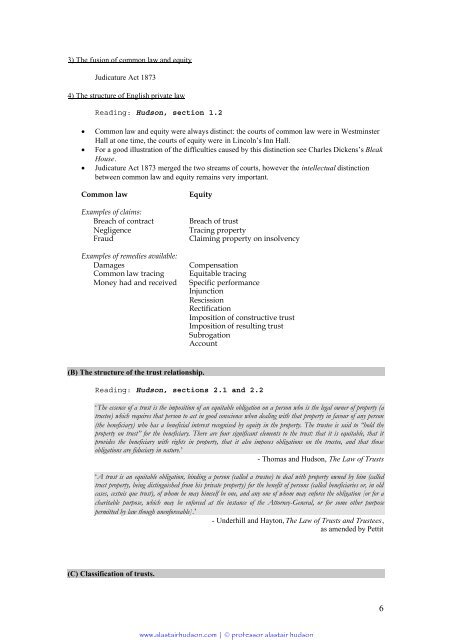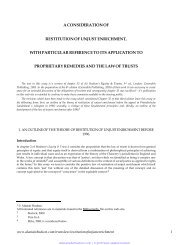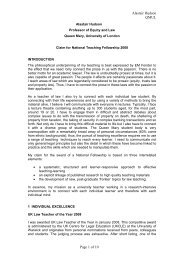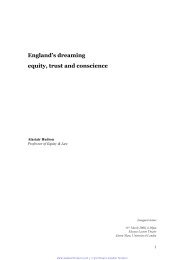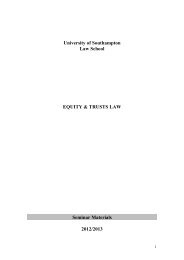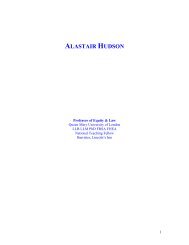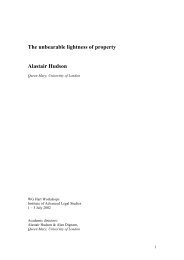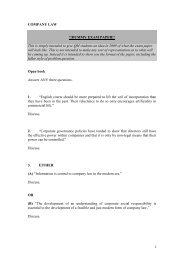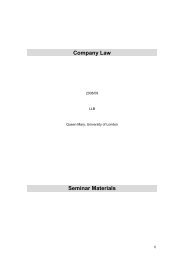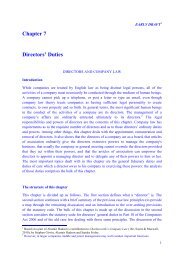Advanced Equity and Trusts Law - alastairhudson.com
Advanced Equity and Trusts Law - alastairhudson.com
Advanced Equity and Trusts Law - alastairhudson.com
You also want an ePaper? Increase the reach of your titles
YUMPU automatically turns print PDFs into web optimized ePapers that Google loves.
3) The fusion of <strong>com</strong>mon law <strong>and</strong> equity<br />
Judicature Act 1873<br />
4) The structure of English private law<br />
Reading: Hudson, section 1.2<br />
� Common law <strong>and</strong> equity were always distinct: the courts of <strong>com</strong>mon law were in Westminster<br />
Hall at one time, the courts of equity were in Lincoln’s Inn Hall.<br />
� For a good illustration of the difficulties caused by this distinction see Charles Dickens’s Bleak<br />
House.<br />
� Judicature Act 1873 merged the two streams of courts, however the intellectual distinction<br />
between <strong>com</strong>mon law <strong>and</strong> equity remains very important.<br />
Common law <strong>Equity</strong><br />
Examples of claims:<br />
Breach of contract Breach of trust<br />
Negligence Tracing property<br />
Fraud Claiming property on insolvency<br />
Examples of remedies available:<br />
Damages Compensation<br />
Common law tracing Equitable tracing<br />
Money had <strong>and</strong> received Specific performance<br />
Injunction<br />
Rescission<br />
Rectification<br />
Imposition of constructive trust<br />
Imposition of resulting trust<br />
Subrogation<br />
Account<br />
(B) The structure of the trust relationship.<br />
Reading: Hudson, sections 2.1 <strong>and</strong> 2.2<br />
‘The essence of a trust is the imposition of an equitable obligation on a person who is the legal owner of property (a<br />
trustee) which requires that person to act in good conscience when dealing with that property in favour of any person<br />
(the beneficiary) who has a beneficial interest recognised by equity in the property. The trustee is said to “hold the<br />
property on trust” for the beneficiary. There are four significant elements to the trust: that it is equitable, that it<br />
provides the beneficiary with rights in property, that it also imposes obligations on the trustee, <strong>and</strong> that those<br />
obligations are fiduciary in nature.’<br />
- Thomas <strong>and</strong> Hudson, The <strong>Law</strong> of <strong>Trusts</strong><br />
‘A trust is an equitable obligation, binding a person (called a trustee) to deal with property owned by him (called<br />
trust property, being distinguished from his private property) for the benefit of persons (called beneficiaries or, in old<br />
cases, cestuis que trust), of whom he may himself be one, <strong>and</strong> any one of whom may enforce the obligation [or for a<br />
charitable purpose, which may be enforced at the instance of the Attorney-General, or for some other purpose<br />
permitted by law though unenforceable].’<br />
- Underhill <strong>and</strong> Hayton, The <strong>Law</strong> of <strong>Trusts</strong> <strong>and</strong> Trustees,<br />
as amended by Pettit<br />
(C) Classification of trusts.<br />
www.<strong>alastairhudson</strong>.<strong>com</strong> | © professor alastair hudson<br />
6


